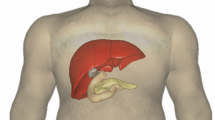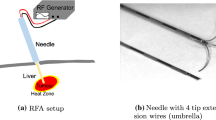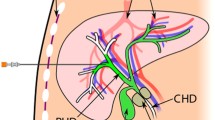Abstract
Needle-based intervention is part of minimally invasive surgery and has the benefit of allowing the reach of deep internal organ structures while limiting trauma. However, reaching good performance requires a skilled practitioner. This paper presents a needle-insertion training simulator for the liver based on the finite element method. One of the main challenges in developing realistic training simulators is to use fine meshes to represent organ deformations accurately while keeping a real-time constraint in the speed of computation to allow interactivity of the simulator. This is especially true for simulating accurately the region of the organs where the needle is inserted. In this paper, we propose the use of model order reduction to allow drastic gains in performance. To simulate accurately the liver which undergoes highly nonlinear local deformation along the needle-insertion path, we propose a new partition method for model order reduction: applied to the liver, we can perform FEM computations on a high-resolution mesh on the part in interaction with the needle while having model reduction elsewhere for greater computational performances. We show the combined methods with an interactive simulation of percutaneous needle-based interventions for tumor biopsy/ablation using patient-based anatomy.
Access this chapter
Tax calculation will be finalised at checkout
Purchases are for personal use only
Similar content being viewed by others
References
N. J. Cowan, K. Goldberg, G. S. Chirikjian, G. Fichtinger, R. Alterovitz, K. B. Reed, V. Kallem, W. Park, S. Misra, and A. M. Okamura, “Robotic needle steering: Design, modeling, planning, and image guidance,” Surg. Robot., pp. 557-582, 2011.
T. L. De Jong, N. J. van de Berg, L. Tas, A. Moelker, J. Dankelman, and J. J. van den Dobbelsteen, “Needle placement errors: Do we need steerable needles in interventional radiology?,” Med. Devices Evid. Res., vol. 11, pp. 259-265, 2018.
R. Taschereau, J. Pouliot, J. Roy, and D. Tremblay, “Seed misplacement and stabilizing needles in transperineal permanent prostate implants,” Radiother. Oncol., vol. 55, no. 1, pp. 59-63, Apr. 2000.
J. T. Hing, A. D. Brooks, and J. P. Desai, “Reality-based needle insertion simulation for haptic feedback in prostate brachytherapy,” in Proceedings - IEEE International Conference on Robotics and Automation, 2006, vol. 2006, pp. 619-624.
G. Ravali and M. Manivannan, “Haptic Feedback in Needle Insertion Modeling and Simulation,” IEEE Rev. Biomed. Eng., vol. 10, no. c, pp. 63-77, 2017.
S. Marchesseau, T. Heimann, S. Chatelin, R. Willinger, and H. Delingette, “Multiplicative Jacobian Energy Decomposition Method for Fast Porous Visco-Hyperelastic Soft Tissue Model,” in Lecture notes in computer science, vol. 6361, no. PART 1, Springer, 2010, pp. 235-242.
Ma Alamilla, Charles Barnouin, Richard Moreau, Florence Zara, Fabrice Jaillet, et al.. A Virtual Reality and haptic simulator for ultrasound-guided needle insertion. IEEE Transactions on Medical Robotics and Bionics, IEEE, 2022, https://doi.org/10.1109/TMRB.2022.3175095 . hal-03657576
Pepley, D. F., Yovanoff, M. A., Mirkin, K. A., Miller, S. R., Han, D. C., Moore, J. Z. (2018). "Integrating cadaver needle forces into a haptic robotic simulator". Journal of Medical Devices, Transactions of the ASME, 12(1). https://doi.org/10.1115/1.4038562
Di Vece, C., Luciano, C., & de Momi, E. (2021). "Psychomotor skills development for Veress needle placement using a virtual reality and haptics-based simulator". International Journal of Computer Assisted Radiology and Surgery, 16(4), 639-647. https://doi.org/10.1007/s11548-021-02341-0
Peterlik, I., Duriez, C., Cotin, S. (2011). "Asynchronous Haptic Simulation of Contacting Deformable Objects with Variable Stiffness". https://doi.org/10.0/Linux-x86_64
Przemieniecki, Janusz S. Theory of matrix structural analysis. Courier Corporation, 1985.
Ryckelynck, D., 2005. A priori hyperreduction method: an adaptive approach. Journal of computational physics, 202(1), pp.346-366.
Goury, Olivier, and Christian Duriez. "Fast, generic, and reliable control and simulation of soft robots using model order reduction." IEEE Transactions on Robotics 34.6 (2018): 1565-1576.
Kerfriden, P., Goury, O., Rabczuk, T. and Bordas, S.P.A., 2013. A partitioned model order reduction approach to rationalise computational expenses in nonlinear fracture mechanics. Computer methods in applied mechanics and engineering, 256, pp.169-188.
Bordas, S., Kerfriden, P., Courtecuisse, H., Duriez, C., Cotin, S., Goury, O., ... & Hale, J. (2016). Simulating topological changes in real time for surgical assistance.
Kerfriden, P., Passieux, J.C., Bordas, S.P.A. (2012) Local/global model order reduction strategy for the simulation of quasi-brittle fracture.
Acknowledgments
This work was funded by the French National Research Agency (ANR) through the project ANR-21-CE45-0031 SPECULAR.
Author information
Authors and Affiliations
Corresponding author
Editor information
Editors and Affiliations
Ethics declarations
Disclosure of Interests
The authors have no competing interests.
Rights and permissions
Copyright information
© 2024 The Author(s), under exclusive license to Springer Nature Switzerland AG
About this paper
Cite this paper
Vanneste, F. et al. (2024). Towards Realistic Needle Insertion Training Simulator Using Partitioned Model Order Reduction. In: Linguraru, M.G., et al. Medical Image Computing and Computer Assisted Intervention – MICCAI 2024. MICCAI 2024. Lecture Notes in Computer Science, vol 15006. Springer, Cham. https://doi.org/10.1007/978-3-031-72089-5_62
Download citation
DOI: https://doi.org/10.1007/978-3-031-72089-5_62
Published:
Publisher Name: Springer, Cham
Print ISBN: 978-3-031-72088-8
Online ISBN: 978-3-031-72089-5
eBook Packages: Computer ScienceComputer Science (R0)





